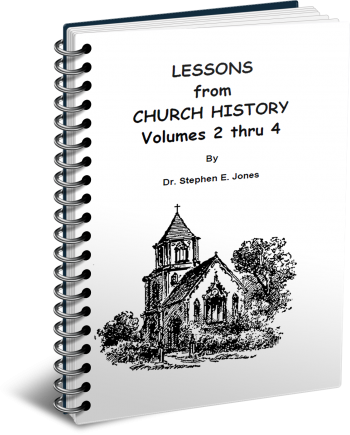Latest Posts
View the latest posts in an easy-to-read list format, with filtering options.

Volumes 2-4. This is the history of the Church from the Roman War (66-73 A.D.) to Constantine and the Council of Nicea in 325 A.D. with lessons to be learned from it.
Category - History and Prophecy

The early second century saw the last of the Hebrew-Christian leaders who left us any sort of legacy in writing. Symeon was martyred in 107, according to Schaff. Ignatius was fed to the lions in 107 or 113. There is also the Epistle of Barnabas called Pseudo-Barnabas, because it is not generally considered to be by the apostle himself but by some other who wrote under his name. Even so, Clement of Alexandria considered it to be genuinely written by Barnabas and treats it as such. And finally, there is the Epistle of Mathetes to Diognetes—a real gem—which is dated in the first half of the second century.
Schaff says that Mathetes was probably a student of the Apostle Paul, for he says, “but having been a disciple of the Apostles, I am become a teacher of the Gentiles” (ch. XI). He says that in his time Christianity “has only now entered into the world, and not long ago” (ch. I). Mathetes focuses much upon the differences between the Jews and Christians—the primary issue up to the Bar-Cochba revolt. The resolution of that revolt and the near destruction of Judaism rendered Jewish opposition a mere secondary issue after 135 A.D. From then on the Church began to focus upon its next rival—Greek religion and philosophies.
Here is a quotation from Mathetes, where he describes the Christians in chapter V:
“They marry, as do all [others]; they beget children; but they do not cast away fetuses [commit abortion]. They have a common table, but not a common bed [sharing wives, as the Gnostics did]. They are in the flesh, but they do not live after the flesh. They pass their days on earth, but they are citizens of heaven. They obey the prescribed laws, and at the same time surpass the laws by their lives.
“They love all men, and are persecuted by all. They are unknown and condemned; they are put to death, and restored to life. They are poor, yet make many rich; they are in lack of all things, and yet abound in all; they are dishonoured, and yet in their very dishonour are glorified. They are evil spoken of, and yet are justified; they are reviled and bless; they are insulted, and repay the insult with honour; they do good, yet are punished as evil-doers. When punished, they rejoice as if quickened into life; they are assailed by the Jews as foreigners, and are persecuted by the Greeks; yet those who hate them are unable to assign any reason for their hatred.”
Likewise, the Epistle of Barnabas is early enough to focus upon subjects that are of interest and concern to the Jews. His interpretation of the law is prophetic and allegorical, as he searches for the underlying meaning of the laws. He says that the animal sacrifices were abolished (ch. II) and gives Old Testament passages to support this. The Jews suffered the fate of the Old Covenant, with Jerusalem broken even as Moses broke the tables of stone. The Christians, on the other hand, were established by a New Covenant (which, like the second tablets, were not broken when Moses descended from the mount with his face glorified).
Barnabas takes the red heifer as a type of Christ (ch. VIII), and then shows that circumcision is now of the heart, rather than of the flesh. He then deals with the unclean animals and why they were forbidden. Knowing nothing of health principles, of course, he sets forth the allegorical meaning. For example,
“For this reason he named the swine, as much as to say, ‘Thou shalt not join thyself to men who resemble swine’ [in their actions]. For when they live in pleasure, they forget the Lord; but when they come to want, they acknowledge the Lord. And [in like manner] the swine, when it has eaten, does not recognize its master; but when hungry it cries out, and on receiving food is quiet again.”
My own understanding of the biblical food laws is set forth in my audio tape: How to Eat Clean Spiritual Food. My views differ somewhat from Barnabas, because my view is more prophetic than allegorical. There is a difference between prophetic types and allegory. Types prophesy of greater events or better conditions yet to come; allegories focus primarily upon the “spiritual meaning” of a passage.
Barnabas also comments on “the true and false Sabbath” in chapter XV, where he says,
“Attend, my children, to the meaning of this expression, ‘He finished it [creation] in six days.’ This implieth that the Lord will finish all things in six thousand years, for a day is with Him a thousand years. Therefore, my children, in six days, that is, in six thousand years, all things will be finished. ‘And He rested on the seventh day.’ This meaneth: when His Son, coming [again], shall destroy the time of the wicked man, and judge the ungodly, and change the sun, and the moon, and the stars, then shall He truly rest on the seventh day.”
This reflected the common Jewish view as well, and Barnabas retains it in the Church with only some Christian modifications, as he explains. Thus, he shows that the time of man's labor on earth is for 6,000 years, with a Sabbath Millennium following, wherein God gives the earth a rest. In my view, the earth has been laboring under “Mystery Babylon” in the final phase of this bondage, and God will destroy that entity at the beginning of the Great Sabbath. That Sabbath Millennium will be a time of rest, healing, and of teaching the Word, and all nations will come to the New Jerusalem and to the heavenly Mount Sion (Isaiah 2:3; Heb. 12:22) to learn of His ways.
One other learned bishop of the early second century was Papias, bishop of Hierapolis, a city of Phrygia in Asia Minor. Irenaeus tells us that he wrote five books, but unfortunately, all of them are lost to us today. What remains are only quotations from other authors. These quotations are called “Fragments” by the historians.
Papias [70-155 A.D.] was a disciple of John. He was martyred about 155 or possibly in 163 A.D., around the time that his friend Polycarp was martyred. Papias was one of the last true Hebrew Christians, for after him the more Grecianized writers dismissed his views of the Sabbath Millennium as “millennarian.” We know his view from Fragment IX, where he is mentioned by Anastasius Sinaita:
“Taking occasion from Papias of Hierapolis, the illustrious, a disciple of the apostle who leaned on the bosom of Christ, and Clemens, and Pantaenus the priest of [the Church] of the Alexandrians, and the wise Ammonius, the ancient and first expositors, who agreed with each other, who understood the work of the six days as referring to Christ and the whole Church.”
Here is a whole list of illustrious early Church leaders who are said to have been in agreement with the idea of the Great Sabbath Millennium before the middle of the second century. In my view, it is tragic that it did not survive the allegorical views of the later Greek Church. The idea of a Millennium seems to have died out with the Hebrew Christians.
But a shift in thinking was inevitable as the apostles died along with their immediate disciples who knew them personally. It was not that the Church became paganized by the converted Greeks, as some have taught, but rather that their cultural backgrounds, values, and manner of thinking changed from Hebrew to Greek over the course of a century. Far from discarding Scripture altogether, this only affected their interpretation of Scripture, or rather their method of interpretation, which shifted from spiritual to allegorical almost imperceptibly.
In that day this shift was designed to win the Greeks by arguing Scripture on their own stage. But in doing so, they lost something in the translation. In my view, we ought to discard the Greek need to allegorize everything, and get back to the thoughts, words, and intent of the Hebrew prophets, as interpreted by the New Testament writers, who were all Hebrews except for Luke.